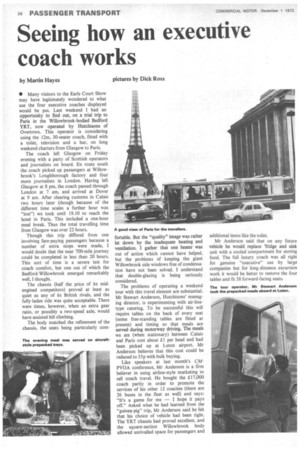Seeing how an executive coach works
Page 28

If you've noticed an error in this article please click here to report it so we can fix it.
by Martin Hayes
• Many visitors to the Earls Court Show may have legitimately wondered to what use the four executive coaches displayed would be put. Last weekend I had an opportunity to find out, on a trial trip to Paris in the Willowbrook-bodied Bedford YRT, now operated by Hutchisons of Overtown. This operator is considering using the 12m, 30-seater coach, fitted with a toilet, television and a bar, on long weekend charters from Glasgow to Paris.
The coach left Glasgow on Friday evening with a party of Scottish operators and journalists on board. En route south the coach picked up passengers at Willowbrook's Loughborough factory and four more journalists in London. Having left Glasgow at 8 pm, the coach passed through London at 7 am, and arrived at Dover at 9 am. After clearing customs in Calais two hours later (though because of the different time scales a further hour was "lost") we took until 19.10 to reach the hotel in Paris. This included a one-hour meal break. Thus the total travelling time from Glasgow was over 22 hours.
Though this trip differed from one involving fare-paying passengers because a number of extra stops were made, I would doubt that the near 700-mile journey could be completed in less than 20 hours. This sort of time is a severe test for coach comfort, but one out of which the Bedford-Willowbrook emerged remarkably well, I thought.
The chassis (half the price of its midengined competitors) proved at least as quiet as any of its British rivals, and the fully-laden ride was quite acceptable. There were times, however, when an extra gear ratio, or possibly a two-speed axle, would have assisted hill climbing.
The body matched the refinement of the chassis, the seats being particularly corn fortable. But the "quality" image was rather let down by the inadequate heating and ventilation. I gather that one heater was out of action which cannot have helped, but the problems of keeping the giant Willowbrook side windows free of condensation have not been solved. I understand that double-glazing is being seriously considered.
The problems of operating a weekend tour with this travel element are substantial. Mr Stewart Anderson, Hutchisons' managing director, is experimenting with air-linetype catering. To be successful this will require tables on the back of every seat (some free-standing tables are fitted at present) and timing so that meals are served during motorway driving. The meals we ate (when stationary) between Calais and Paris cost about £1 per head and had been picked up at Luton airport. Mr Anderson believes that this cost could be reduced to 55p with bulk buying.
Like speakers at last month's CMPVOA conference, Mr Anderson is a firm believer in using airline-style marketing to sell coach travel. He bought the £17,000 coach partly in order to promote the services of his other 12 coaches (there are 26 buses in the fleet as well) and says: "It's a game for me — I hope it pays off." Asked what he had learned from the "guinea-pig" trip, Mr Anderson said he felt that his choice of vehicle had been right. The YRT chassis had proved excellent, and the square-section Willowbrook body allowed unrivalled space for passengers and
additional items like the toilet.
Mr Anderson said that on any future vehicle he would replace 'fridge and sink unit with a cooled compartment for storing food. The full luxury coach was all right for genuine "executive" use by large companies but for long-distance excursion work it would be better to remove the four tables and fit 38 forward-facing seats.
































































































































